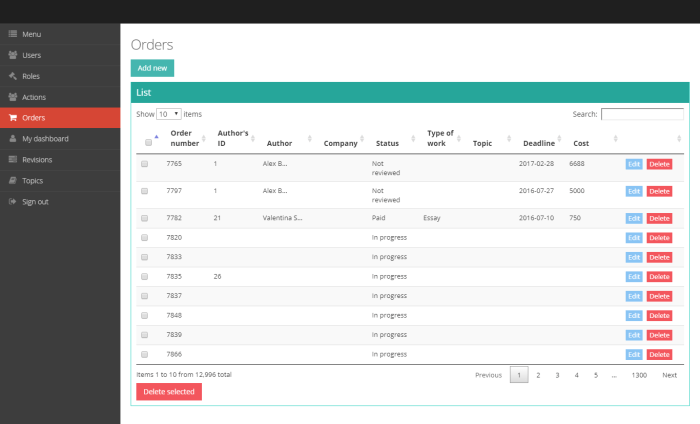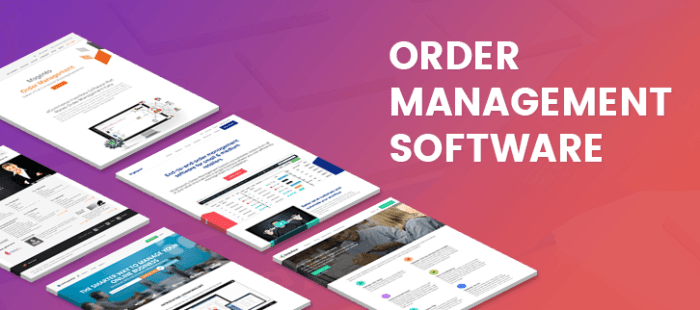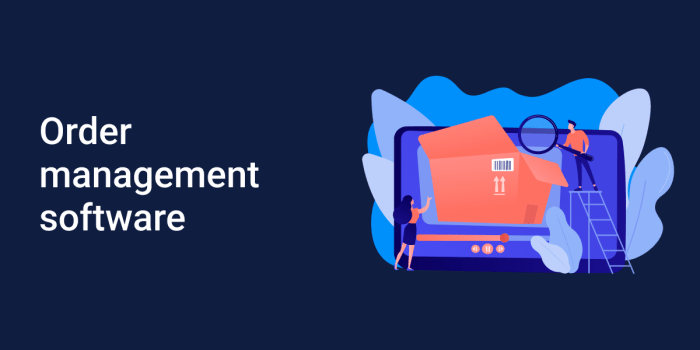Crm and order management software – In today’s dynamic business landscape, efficient management of customer relationships and orders is paramount for success. This necessitates the integration of robust software solutions. This comprehensive guide delves into the intricacies of CRM (Customer Relationship Management) and order management software, exploring their individual functionalities, synergistic benefits when integrated, and the key factors to consider when selecting the right software for your business needs.

Source: specialcase.net
We’ll cover topics such as inventory management, sales forecasting, customer service automation, and more, providing a detailed overview for businesses of all sizes.
Understanding Customer Relationship Management (CRM) Software
CRM software is designed to centralize and streamline all interactions with customers. From initial contact to ongoing support, a CRM system provides a single source of truth for all customer-related data. This allows businesses to gain a deeper understanding of their customer base, personalize interactions, and improve overall customer satisfaction. Key features of a robust CRM system include:
Core CRM Features:, Crm and order management software
- Contact Management: Storing and organizing customer information, including contact details, purchase history, and communication logs. This facilitates personalized communication and targeted marketing campaigns.
- Sales Force Automation (SFA): Automating sales processes, such as lead generation, opportunity tracking, and sales forecasting. This improves sales efficiency and accelerates the sales cycle.
- Marketing Automation: Automating marketing tasks, such as email marketing, social media campaigns, and targeted advertising. This helps nurture leads and build stronger customer relationships.
- Customer Service Management: Managing customer inquiries and resolving issues efficiently. This often includes features like ticketing systems, knowledge bases, and live chat integration.
- Reporting and Analytics: Generating reports and dashboards to track key metrics, such as customer acquisition cost, customer lifetime value, and sales conversion rates. This data-driven approach enables informed decision-making.
Examples of popular CRM platforms include Salesforce, HubSpot, Zoho CRM, and Microsoft Dynamics 365. The choice of CRM depends on factors like business size, budget, and specific requirements. Consider cloud-based vs. on-premise deployment, integration capabilities, and scalability when making your selection.
Understanding Order Management Software
Order management software (OMS) streamlines the entire order fulfillment process, from order placement to delivery. It integrates with various systems, including e-commerce platforms, inventory management systems, and shipping carriers, to provide a unified view of the order lifecycle. Key features of effective OMS include:
Core OMS Features:
- Order Processing: Automating order entry, processing, and tracking. This reduces manual errors and accelerates order fulfillment.
- Inventory Management: Tracking inventory levels in real-time, managing stock replenishment, and preventing stockouts. This ensures that orders can be fulfilled promptly and efficiently.
- Warehouse Management: Optimizing warehouse operations, such as picking, packing, and shipping. This improves efficiency and reduces costs.
- Shipping and Delivery: Integrating with shipping carriers to generate shipping labels, track shipments, and manage returns. This provides customers with real-time visibility into their order status.
- Returns Management: Streamlining the returns process, including processing returns, issuing refunds, and managing inventory. This improves customer satisfaction and reduces costs associated with returns.
- Reporting and Analytics: Providing insights into order fulfillment performance, such as order cycle time, on-time delivery rates, and return rates. This data helps identify areas for improvement.
Popular OMS platforms include NetSuite, Shopify Order Management, Brightpearl, and Cin7. Choosing the right OMS depends on factors such as order volume, complexity of fulfillment processes, and integration needs with existing systems. Scalability and flexibility are crucial considerations.
The Synergistic Power of Integrated CRM and Order Management Software
Integrating CRM and OMS creates a powerful synergy, enhancing operational efficiency and customer satisfaction. When these systems communicate seamlessly, businesses gain a 360-degree view of their customers and their orders. This allows for personalized service, proactive issue resolution, and data-driven decision-making. Key benefits of integration include:
Benefits of Integration:
- Improved Customer Service: Agents have access to complete customer history and order details, enabling them to provide personalized and efficient support.
- Enhanced Order Accuracy: Reduced errors in order processing due to streamlined data flow between systems.
- Faster Order Fulfillment: Automated workflows and real-time inventory visibility accelerate the order fulfillment process.
- Better Inventory Management: Accurate demand forecasting based on sales data and customer preferences improves inventory control.
- Data-Driven Decision Making: Integrated data provides valuable insights into customer behavior, sales trends, and operational performance.
- Increased Customer Loyalty: Personalized service and efficient order fulfillment contribute to higher customer satisfaction and loyalty.
Choosing the Right CRM and Order Management Software
Selecting the appropriate software requires careful consideration of several factors:
Key Selection Criteria:
- Business Size and Needs: Small businesses may require simpler, more affordable solutions, while larger enterprises may need more sophisticated and scalable systems.
- Budget: Consider licensing fees, implementation costs, and ongoing maintenance expenses.
- Integration Capabilities: Ensure that the software integrates seamlessly with existing systems, such as e-commerce platforms, accounting software, and shipping carriers.
- Scalability: Choose software that can grow with your business, accommodating increasing order volume and customer base.
- User-Friendliness: The software should be intuitive and easy to use for all employees.
- Customer Support: Reliable customer support is essential for resolving issues and getting assistance when needed.
Frequently Asked Questions (FAQ)
- Q: What is the difference between CRM and OMS? A: CRM focuses on managing customer relationships, while OMS focuses on managing the order fulfillment process. They are distinct but complementary systems.
- Q: Do I need both CRM and OMS software? A: While not always mandatory, integrating both systems offers significant benefits in terms of efficiency and customer satisfaction, especially as your business grows.
- Q: How much does CRM and OMS software cost? A: Costs vary widely depending on the vendor, features, and number of users. Expect a range from affordable monthly subscriptions to significant upfront investments for enterprise-level solutions.
- Q: How long does it take to implement CRM and OMS software? A: Implementation time depends on the complexity of the software and the size of your business. It can range from a few weeks to several months.
- Q: Can I integrate my existing systems with CRM and OMS software? A: Many CRM and OMS platforms offer robust integration capabilities with various third-party systems. Check the vendor’s documentation to ensure compatibility.
Conclusion
Implementing robust CRM and order management software is a strategic investment that can significantly enhance business operations and customer satisfaction. By carefully evaluating your business needs and selecting the right software, you can streamline processes, improve efficiency, and gain a competitive edge in today’s market. The synergistic power of integrated CRM and OMS allows for a holistic view of your business, driving informed decision-making and fostering stronger customer relationships.
Call to Action
Ready to optimize your business processes and elevate customer experiences? Contact us today for a consultation to discuss your specific needs and explore the best CRM and order management solutions for your business.
Essential FAQs
What are the benefits of integrating CRM and order management?
Integration provides a unified view of customers and their orders, leading to improved customer service, streamlined processes, reduced errors, and better data-driven decision-making.

Source: woofresh.com
How much does CRM and order management software cost?

Source: bordio.com
Costs vary widely depending on the features, scalability, and vendor. Expect a range from affordable cloud-based options to enterprise-level solutions with substantial upfront investments.
What are some key features to look for in CRM and order management software?
Essential features include customer relationship management tools, order tracking and management, inventory control, automated workflows, reporting and analytics, and integration with other business systems.
Is CRM and order management software suitable for small businesses?
Yes, many vendors offer scalable solutions tailored to small businesses, providing affordable and user-friendly options to manage customer relationships and orders effectively.
